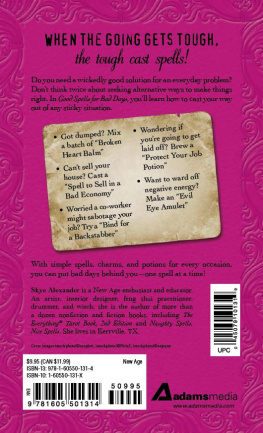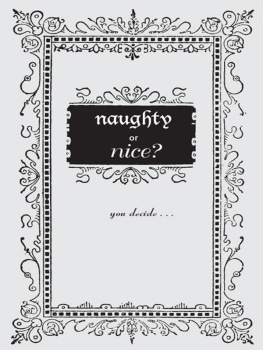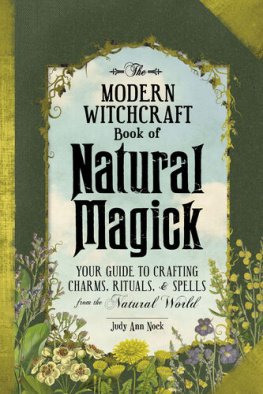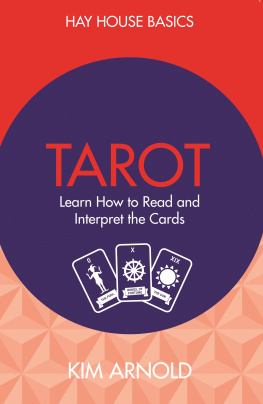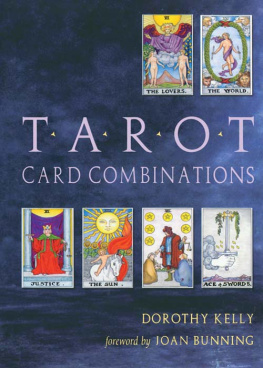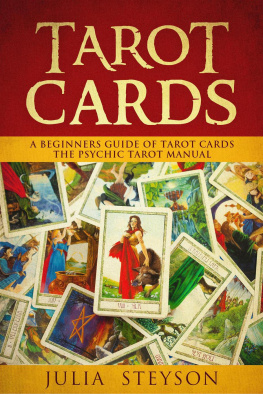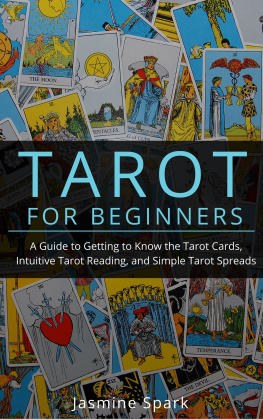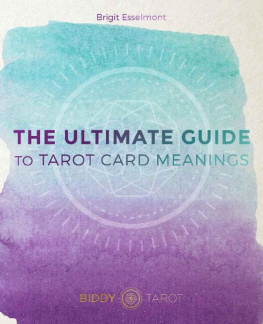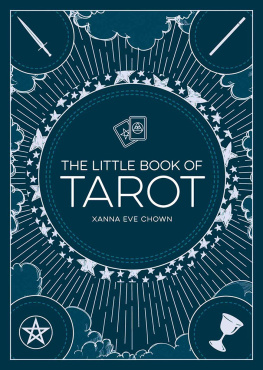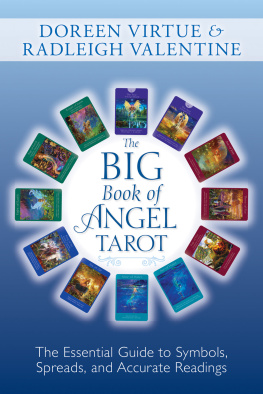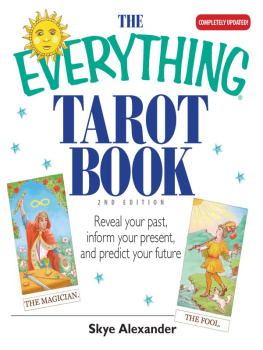The Only
TAROT
Book Youll
Ever Need
INTERPRET THE CARDS
THAT HOLD YOUR FUTURE
SKYE ALEXANDER

Copyright 2008 by F+W Media, Inc.
Contains material adopted and abridged from
The Everything Tarot Book, 2nd Edition by Skye Alexander,
Copyright 1999, 2006 by F+W Media, Inc.
All rights reserved. This book, or parts thereof, may not be reproduced
in any form without permission from the publisher; exceptions
are made for brief excerpts used in published reviews.
Published by
Adams Media, a division of F+W Media, Inc.
57 Littlefield Street, Avon, MA 02322. U.S.A.
www.adamsmedia.com
ISBN 10: 1-59869-489-8
ISBN 13: 978-1-59869-489-5
eISBN: 978-1-44051-496-8
Printed in the United States of America.
10 9 8 7 6 5 4 3
Library of Congress Cataloging-in-Publication Data
is available from the publisher.
This publication is designed to provide accurate and authoritative information with regard to the subject matter covered. It is sold with the understanding that the publisher is not engaged in rendering legal, accounting, or other professional advice. If legal advice or other expert assistance is required, the services of a competent professional person should be sought.
From a Declaration of Principles jointly adopted by a Committee of the
American Bar Association and a Committee of Publishers and Associations
Many of the designations used by manufacturers and sellers to distinguish their product are claimed as trademarks. Where those designations appear in this book and Adams Media was aware of a trademark claim, the designations have been printed with initial capital letters.
Illustrations from the Rider-Waite Tarot Deck reproduced by permission of U.S. Games Systems, Inc., Stamford, CT 06902 USA. Copyright 1971 by U.S. Games Systems, Inc. Further reproductions prohibited. The Rider-Waite Tarot Deck is a registered trademark of U.S. Games Systems, Inc.
This book is available at quantity discounts for bulk purchases.
For information, please call 1-800-289-0963.
Contents
ONE
Introduction to the Tarot
TWO
Sifting Through Symbols and Signs
THREE
A Path to Personal Growth
FOUR
The Players of the Major Arcana
FIVE
Interpreting the Minor Arcana
SIX
Looking Deeper:
Seven Important Spreads
SEVEN
Tarots Potential Is Never
Fully Tapped
Introduction
Considering that this book is titled The Only Tarot Book Youll Ever Need, you might be surprised to see such a concise and uncomplicated approach to a centuries-old, esoteric topic. After all, wise men and women, sages and sorcerers, world leaders, noted artists, and the intelligentsia of many nations have consulted the Tarot order to discover the secrets of the universe. Its mystical nature and multi-layered symbolism seem to suggest that you could study this ancient oracle for an entire lifetime and barely scratch the surface.
Although this may be true, one of the wonderful things about the Tarot is you dont have to be a scholar or a magician to use this colorful oracle. Thats because the Tarot, like dreams, presents images that trigger your intuition and speak to your inner knowing. Its a right-brain tool, not a left-brain one. Its purpose is to help you probe your own subconscious and to find answers within yourself. Consequently, immediate impressions can sometimes be more meaningful than lengthy, intellectual analysis.
When you gaze at Tarot cards, you allow the images to connect with the vast storehouse of knowledge you possess including things you dont even realize you know. The scenarios, colors, and numbers shown on the cards expand your vision and let you see what lies beyond the surface of everyday reality. They speak to the creative part of your mind, the part that serves as the architect of your life, to guide you in making choices.
Initially, youll probably be intrigued by the sometimes strange images on the cards. Why is that man hanging upside down? Why are those Sphinx-like creatures pulling a chariot? In earlier times, religious and political authorities took an extremely dim view of the Tarot and other forms of divination. Therefore, the Tarots originators created a secret, symbolic language to safely convey the hidden wisdom of the Tarot and the magic behind it.
When learning a language, you begin with the ABCs. This book is intended to provide the fundamentals of the Tarot. Standard interpretations of each card are included here to give you a framework that will enable you to develop your own, personal dialogue with the cards. Youll also learn how to use spreadsgroupings of cards that tell a story. Spreads let you see the links between past, present, and futurehow your thoughts and actions manifest your reality.
Explore. Engage your curiosity. Use your imagination. Keep an open mind and an open heart. The Tarot isnt just for answering everyday questions or telling fortunes; it is a beacon that shines light into the darkest recesses of your inner self and illuminates the vast realms that lie beyond the limits of the conscious mind.
ONE
Introduction to the Tarot
The History and Mystery of the Tarot
No one knows exactly when or where the Tarot originated. The earliest known book of Tarot cards still in existence dates back to the early 1840s; seventeen of these antique cards still remain. The first entire deck still in existence was painted by the Italian artist Bonifacio Bembo for the Duke of Milan.
Many theories abound about the Tarots beginnings. One is that the great library of Alexandria in Egypt, whose female librarian Hypatia was world-renowned for her wisdom and learning, housed scrolls containing all the knowledge of the ancient world. Among these scrolls was the legendary Book of Thoth, derived from the mystery schools of ancient Egypt. The allegorical illustrations on Tarot cards are said to contain these secret teachings, which in the Major Arcana represent a course in personal and spiritual development. The Minor Arcana, which was added to the Tarot at a later date, may have derived from an Italian card game known as tarrochi. Our present-day poker decks closely resemble the Minor Arcana of the Tarot.
Tarot images are inextricably linked to ancient beliefs, mythologies, and religious systems such as the Hebrew Kabbalah. The cards numerological associations have been tied to the Greek mathematician Pythagoras, who taught that letters and numbers contain divine essence and extraordinary powers unrealized by the uninitiated.
Gypsies may have carried the cards to Europe. (The term Gypsy is considered to be a corrupt form of the word Egyptian.) The Church, however, believed the Tarot was the devils picture book and quickly condemned the cards as heretical. To possess them was dangerous. Thus, during the Middle Ages the Tarot went underground, along with astrology and many other forms of occult knowledge. (Occult simply means hidden.) Yet despite persecution, the knowledge contained in the Tarot continued to be passed down in secret, until interest in the cards surfaced again during the Renaissance.
Though their true history may never be known, you can still use Tarot cards to advise and guide you, to show you what lies ahead, and to gain access to your inner knowing. The amazing insights contained in the Tarot and the decks inherent flexibility make it just as relevant during contemporary times as it was to the ancients.
The Major Arcana and Universal Law
A typical Tarot deck consists of seventy-eight cards. Of these, the first twenty-two are identified as the Major Arcana. The fifty-six remaining cards are called the Minor Arcana, presumably because they contain information that is of a less important or less mystical nature. Because the Tarot can be understood as a body of wisdom and guidance, it is sometimes thought of as a bookor more accurately, as two booksof knowledge.
Next page


